
Looking for the perfect Christmas appetizers for your holiday party? We’ve compiled some of the best traditional and creative appetizers below. Plus, learn more about where each one originated and how you can incorporate them into your holiday traditions.
Christmas Ornament Cheese Balls
Cheese balls make the perfect party appetizer – they’re easy to throw together, everyone loves them, and they can be shaped into an ornament for Christmas! But did you know that the first cheese ball was made for Thomas Jefferson?

In 1801, Elisha Brown, Jr. made a 1,235-lb cheese ball for the President, who called it “Mammoth Cheese”. In 1944, the cheese ball made its appearance in print and then solidly found its place in mid-century appetizers. And it’s still a party favorite!
Oysters with Mignonette
Oysters became popular around the holidays thanks to the Irish who, based on Catholic traditions, abstained from eating meat on Christmas Eve.
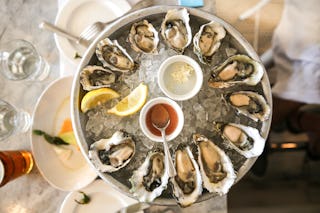
They chose oysters instead, a food that was already plentiful and popular in America. And the classic mignonette sauce of shallots, cracked pepper, and vinegar is the perfect pairing to raw, high-quality oysters.
Bacon Wrapped Dates
Bacon wrapped dates, also called Devils on Horseback, originated in the late 19th century and were based on the Victorian trend of oysters wrapped in bacon.

They became particularly popular in the 1960’s, thanks to America’s deepening love of bacon (I mean, who can blame us?). Now, they’re often seen on Christmas tables as a rich, decadent bite before the meal.
Deviled Eggs with Caviar
Though they’re an American classic, deviled eggs actually originated in Ancient Rome, where they would season boiled eggs with spicy sauces and serve them to the wealthy.

Around 1800, the term “deviled” was used to describe spicy foods. Then, in the 1940’s, recipes for traditional, mayo-based deviled eggs became popular. Adding caviar to the top of deviled eggs became a decadent way to impress Christmas party guests!
Chicken Liver Pate
In the Middle Ages, liver pate was a staple in Europe – a flavorful way to utilize all of the animal.

The French, of course, began playing with the dish, adding more creative flavors and improving the texture. In fact, it’s extremely common in France to this day. Its rich, luxurious flavor makes it a great choice for the holiday table, too!
Spicy Pecans
Pecans are the only major tree nut found natively in North America so colonial Americans loved them! Both George Washington and Thomas Jefferson grew pecans on their estates.
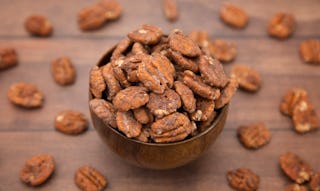
They provide energy and contain vitamins and antioxidants – what’s not to love? So it’s no surprise that pecans roasted with cayenne, salt, and sugar are often featured in our holiday meals.
Chex Party Mix
Full of spicy cereal, crunchy pretzels, nuts and other goodies, Chex party mix is found at many parties around the U.S. It all started with the invention of Wheat Chex cereal in the 1930’s by Ralston Purina.

She published the first recipe for party mix on a box of the cereal in 1952, which included two kinds of Chex, nuts, Worcestershire sauce, butter, garlic salt and salt. While it’s evolved some over the years, it’s still loved by everyone!
Merry Meatballs
Merry Meatballs are similar to a traditional meatball but feature salsa, giving them a spicy kick! Meatballs are thought to originate from kofta, a cylinder of ground meat first found in early Arabic cookbooks.

As a simple, affordable meal or appetizer, meatballs are featured in almost every culture – Italian, Spanish, Duch, African, and Chinese. Their affordability made them popular with Italian immigrants to America, who made the dish popular in our country!
Bloody Mary Shrimp Cocktails
Bloody Mary shrimp cocktails pair juicy, succulent shrimp with the classic, spicy flavors of the Bloody Mary. Bloody Maries began with the introduction of canned tomato juice, which was used as part of a cocktail experiment by a bartender named Ferdinand Petiot.

The drink caught on, especially as a hangover cure, and became a classic. Now, the flavors are found in all kinds of recipes, including delicious shrimp cocktails.
Spinach Artichoke Dip
Spinach artichoke dip is creamy and addicting – a favorite at Christmas parties! Dips started making their appearance in America in the 1950’s, along with TV dinners, because they were easy to eat in front of the television.
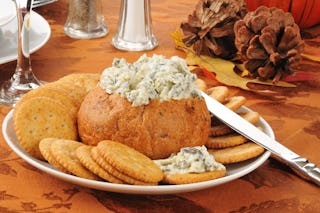
In 1952, Lipton began promoting ways to use their instant soup mixes, pairing them with sour cream for quick dips. While the exact origin of spinach artichoke dip is unknown, it’s thought to have originated from this new focus on party foods!
Marinated Olives
Olive trees were first found in the Mediterranean 6,000 years ago and are actually one of the earliest cultivated trees in the world! In the past few hundred years, they spread across the globe, becoming especially popular with the Franciscans, who planted olive trees in Southern California.

Marinating olives in oil, vinegar, and spices became an easy way to add flavor and established them as an appetizer favorite!
Candied Bacon
As Americans, we’re obsessed with bacon. So it’s no surprise that this sweet and salty version has made its way to our holiday table! While salted pork belly (essentially bacon) originated thousands of years ago, Hernando de Soto brought pigs to America.

Native Americans and colonials fell in love with their porky flavor! Over the years, bacon became an American staple and we eat it for breakfast, as a delicious fatty component of meals, and candied for appetizers and desserts.
Hush Puppies
Made of a cornmeal batter and fried until crispy and golden, hush puppies are a common appetizer in the South. They originated from South Carolinian “red horse bread”, fried cornmeal batter commonly eaten with the red horse fish.

They were eventually called hush puppies and, while the exact origins of the name aren’t clear, it’s thought to have come from the idea of hushing up the puppies that growl in your stomach when hungry!
Arancini Balls
Arancini balls are a delicious Italian street food – rice, cheese, beef and spices fried until golden. They date back to 19th century Sicily and were originally sweet, with sugar, spices, and milk.

The increasing availability of tomatoes revolutionized the dish, turning them into an easy-to-eat, portable snack. Now, they’re loved all over the world and often featured on the holiday table.
Pull-Apart Garlic Bread Tree
Garlic bread is a party favorite, so why not turn it into the shape of a Christmas tree? Our modern-day garlic bread is a spin-off of bruschetta, which originated in Italy as toasted, crusty bread with brushed garlic and a drizzle of olive oil.
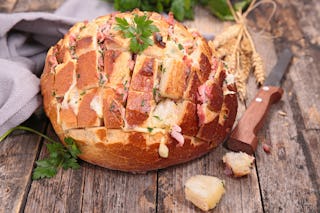
The American version of this adds butter, extra garlic, and often cheese.
Prosciutto Wrapped Asparagus
While the exact history of prosciutto asparagus is tricky to determine, prosciutto itself goes back to pre-Roman times in Northern Italy.

Curing and salting ham was an easy way to preserve meat, which led to the popularity of prosciutto. Now, we often use it as a part of appetizers, wrapping cheese, figs, and, yes, asparagus, in the salty meat.
Cranberry Brie Pastry Bites
The Pilgrims learned of cranberries from the Native Americans, and the fruit is indigenous to the United States. Their red color and the fact that they’re harvested during the winter made them a natural fit for Christmas and, in the 1800’s, people used them as Christmas tree decorations.

Their tart flavor makes them the perfect accompaniment to creamy Brie and, folded into flaky pastry, they’re a great handheld bite.
Gravlax
Gravlax bears some resemblance to Lox; it’s raw salmon cured in salt, sugar, and dill. A Nordic dish, the word means “buried salmon”, named after the way it was created many years ago. In order to store fish throughout the winter, they would wrap it in birch bark and bury it in the cold ground, where it fermented.
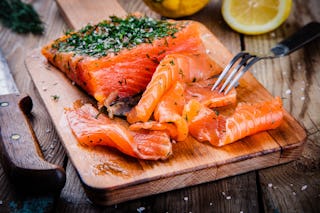
Today, salmon is “buried” in seasonings, where the salt cures and essentially cooks it. Many people, especially those of Nordic descent, eat gravlax as an appetizer at Christmas.
Pirozhki
A pirozhki is a Russian stuffed hand pie that’s the perfect grab-and-go appetizer! The fillings are largely based on crops that grow well in cold climates - like cabbage, grains, and potatoes – in addition to meat and fish.

Traditional Russian food was based on using an oven rather than a stove, so they often relied on baked dishes, like pirozhkis, which were served by themselves or with soup. Of course, they also make the perfect savory appetizer!
Leaf Bread
The beautiful leaf bread is traditionally a French flat bread called Fougasse, which descends from an ancient Roman flat bread that was cooked in the ashes of a wood-burning hearth. The leaf shape came about as a way to cook the bread very quickly; the open areas within the bread that outline the leaf allow air to circulate and help the bread get crispy. Overall, leaf bread is quick and easy to make and looks impressive on the holiday table!
Lefse
Lefse is a Norwegian potato flatbread, similar to a crepe, that often accompanies a meal or is sprinkled with cinnamon and sugar for a delicious, sweet appetizer. The first lefse was made from flour, didn’t contain potatoes, and was designed to be stored throughout the winter months.
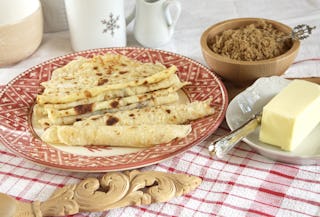
Once cheap, easy-to-grow potatoes were introduced to Norway around 250 years ago, they were added to many foods, including lefse. Lefse is still traditionally eaten with meals and served for the holidays.
Cured Ham Croquettes
Ham and cheese, rolled into balls, breaded, and fried until golden brown; cured ham croquettes make an excellent appetizer that everyone will love. They’re a French dish, created in order to make the most of leftover ingredients during hard times.

They’ve been incorporated into many different cultures and each one has its own spin on flavors! But using cured ham makes them especially easy to make with pantry ingredients.
Lil Smokies Christmas Wreath
Many memories involve lil’ smokies soaking in barbecue sauce in the crockpot, eaten one-by-one during holiday parties and while decorating the tree. To take that to the next level, try wrapping the smoked sausages in crescent dough and shaping them into a Christmas wreath.

Bell pepper strips, cherry tomatoes, and rosemary make the perfect décor!
Cranberry Meatballs
As we mentioned earlier, cranberries are a traditional Christmas food, thanks to the Native Americans and the fact that they’re found natively in North America. Cooking savory meatballs in a cranberry sauce adds a sweet and tart holiday spin to a party favorite.
Green Chicken Tamale
Tamales were found as early as 5000 B.C. in pre-Colombian history. Masa was already a traditional food, but cooking it in corn husks made it easy make ahead and perfect to take on-the-go. The idea spread quickly and tamales became beloved by the Hispanic people, eventually spreading to many other cultures as well.

Since tamales are labor-intensive, they’re often saved for special occasions, like Christmas, and using green chilies gives them a festive flare.